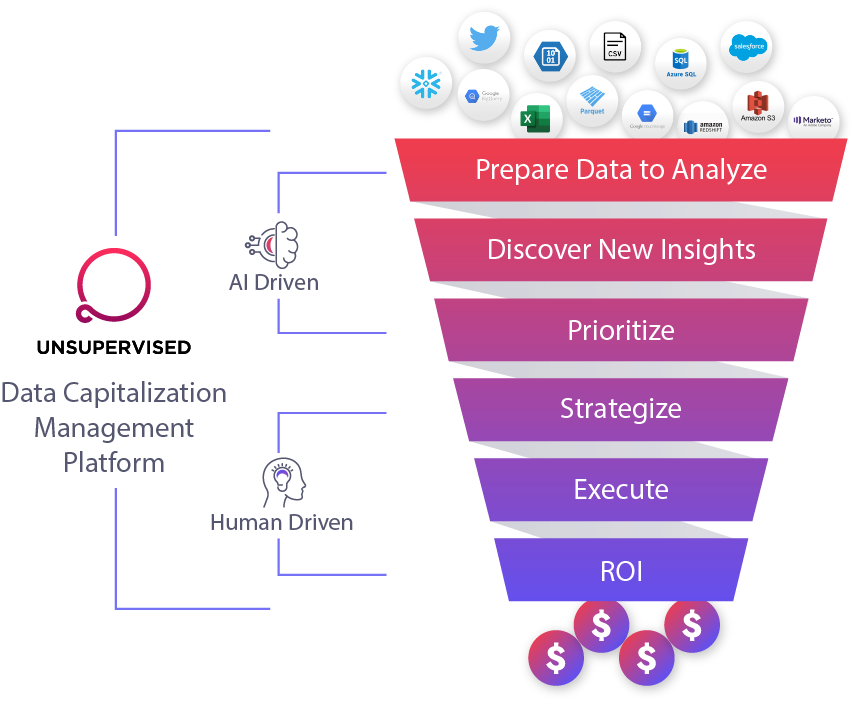Data is one of the most valuable assets a business has. Yet, so many organizations are still struggling to find the insights that drive change in their business. Data Capitalization Management (DCM) is emerging to help organizations overcome persistent obstacles involved in data analysis and start gaining tangible business value from their data. This blog post covers the most common questions regarding DCM and how to become a data-profitable company.
Frequently Asked Questions:
What is Data Capitalization Management?
Data Capitalization Management (DCM) is the practice of transforming an organization’s data into monetary value. This is accomplished by identifying, prioritizing, and tracking insights based on the return on investment (ROI) the business receives.
How is DCM different from business intelligence (BI) and analytics?
BI is about providing a system for monitoring trends in the business, while analytics is about probing into ad hoc questions about the business. DCM automates the discovery of insights impacting Key Performance Indicators (KPIs), helping business teams improve KPI results while providing a workflow for tracking the monetary value of actions taken based on the insights that are discovered. Unlike traditional BI or analytics, DCM platforms focus on tangible, realizable business value by automating the analytics process.
Is Data Capitalization Management a form of machine learning (ML)?
DCM provides a process for transforming complex data into monetary outcomes. DCM providers leverage machine learning to help achieve these outcomes. The platforms at the forefront of this space use unsupervised machine learning — which doesn’t require pre-assigned labels or scores for the data to be analyzed — to automate and greatly enhance the scale of pattern discovery within the data sets.
What are some challenges facing traditional BI and analytics?
BI focuses on the visualization of trends occurring within the business. When the natural question of why these trends occur arises, analytics and data science are used to test pre-formed hypotheses. This is a time-consuming, limited and biased process for identifying the root causes and opportunities within those trends.
Most data is unstructured, whether text, audio, or images, and this data can be highly complex. A traditional team spends most of its time preparing the data — up to 80% of a data scientist’s workday. And it’s the part of the job data scientists find least enjoyable. Too often there is insufficient ROI from AI and analytics investments because it takes too long to generate insights, and too often the insights aren’t actionable. Businesses are learning that databases, dashboards, and visualizations aren’t enough. You need to take action to achieve ROI.
How does Unsupervised implement DCM principles?
Unsupervised automates the discovery of far more insights that impacting the KPIs the business is tracking and attempting to improve. Instead of testing individual hypotheses, the Unsupervised platform highlights things you might not have thought to look for. This is highly important for a simple reason: Unsupervised uses AI to do the difficult work of preparing, enriching, and analyzing data at a greater depth and breadth, and then surfaces the insights from that analysis to the business. That frees up humans to do what they do best, allowing them to devote more time to evaluating results and acting on them.
What kind of companies will benefit most from Data Capitalization Management?
Every kind of company can benefit from Data Capitalization Management. Any company that wants to transform into a digital-first, data-profitable company will gain many benefits — particularly if they don’t have the resources available to the tech giants, such as armies of data scientists.
Can Data Capitalization Management take the place of a data analyst?
Data Capitalization Management is not intended to replace data analysts or analyst teams. Instead, both business and data teams used DCM to identify buried insights across data sources and structures to accelerate decision-making and business outcomes. Often data analysts will use the Unsupervised platform to probe the insights, flag them as potential opportunities, and work with the business team to report on the value those opportunities delivered.
What’s an example of Data Capitalization Management in action?
Charlotte’s Web, makers of non-GMO wellness products, sought to gain a steady stream of customer insights from their data. Unsupervised AI algorithms sifted through reams of complex data, spotlighting patterns relevant to Charlotte’s Web KPIs. Unsupervised discovered more than 50 previously unknown insights of which more than 10 had immediate, actionable implications. One pattern generated more than $100K worth of additional revenue in one month. Overall, Unsupervised has helped Charlotte’s Web discover more than $2.5 million in new opportunities.
Do I need to be an expert in machine learning to use Unsupervised?
The end-user is usually the line-of-business owner but might be a data analyst, or a combination of both. Since it’s not necessary to structure the data, you don’t have to prepare it. You just feed it into the platform.
How can I tell if Unsupervised Data Capitalization Management is delivering value?
Unsupervised is the only platform that delivers the last mile of analytics, including provable value of business initiatives. To measure the ROI of Unsupervised, first identify the KPIs that are most critical to your business, then examine the insights that directly impact these KPIs. With a click, you then turn insights into trackable opportunities on which teams collaborate and track their progress, including the value delivered back to the business.
Start turning your data into dollars with Unsupervised. Speak to a DCM expert today.









